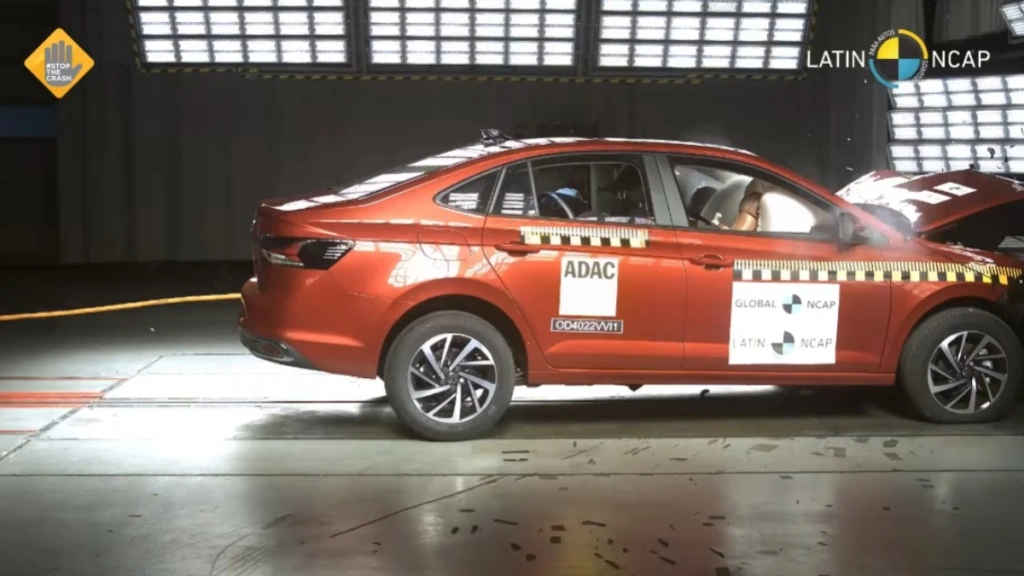
The long-running Vento will be replaced by the Volkswagen Virtus, which goes on sale in June 2022 and has a 12-year production run. The Volkswagen Virtus is the Skoda Slavia’s sibling vehicle and is significantly more expensive. It has a larger footprint, more equipment, and two TSI turbo-petrol powertrains.
In India, the Maruti Suzuki Ciaz, the Honda City, the Skoda Slavia, and the Hyundai Verna are competitors of the Volkswagen Virtus.
Volkswagen doesn’t appear to make any compromises when it comes to safety. In fact, the VW Polo was among the first vehicles assessed when Global NCAP launched the Safer Cars For India campaign. Due to the absence of airbags on the base model, it received a startling 0-star rating.
As soon as possible, VW made twin airbags a requirement for all Polo models. Polo received an exceptional 4-star rating on the retest for adult protection and 3 stars for child protection. Recent GNCAP tests under their new protocols yielded 5-star ratings for both the VW Taigun and Skoda Kushaq.
The Virtus and Slavia sedans, as well as the Taigun and Kushaq, are all based on the MQB A0 IN. Virtus, which is marketed as New Virtus in South America, also received a 5-star rating from Latin NCAP.
5-Star Safety Rating
It should be noted that the testing procedures used by each NCAP institution differ depending on industry standards. However, there isn’t much difference between them. The new Virtus available in Latin America is thought to be very comparable to the Virtus available in India. The test vehicle reportedly has six airbags and was based on the MQB A0 IN.
Latin NCAP performed a variety of testing, including pedestrian adult and kid head form to bonnet tests at 40 km/h, autonomous emergency braking tests, side mobile barrier tests at 50 km/h, side pole impact tests at 29 km/h, and more.
Frontal Impact:

It was discovered that the head and neck protection provided to the driver and passenger was good. Both the driver’s and the passenger’s chests received good protection. The knees of the driver and passenger both displayed good protection. Additionally, the right and left tibias of the passenger as well as the driver’s tibia displayed good protection. The Volkswagen Virtus’ footwell was deemed to be symmetrical and stable on both the driver and passenger sides. Generally speaking, the bodyshell of the car was rated as stable and able to handle additional loads. Latin NCAP found that the head, abdomen, and pelvis were well protected from side impacts. Additionally, chest protection was sufficient.
Auto Emergency Brake(AEB)
The results of an auto emergency braking side pole impact showed that protection for the head, abdomen, and pelvis was excellent, while protection for the chest was just fair. According to the whiplash test, the Virtus seat offers good neck protection for adults. The UN R32 test protocol showed that Virtus also complies with the criteria for rear-impact structures.
AEB City tests reveal that the vehicle satisfies the technical and accessibility requirements of Latin NCAP. Latin NCAP criteria are accessible on a rescue sheet. It should be noted that the Virtus manufactured for India lacks ADAS functionality. It lacks active safety features like the automatic emergency braking that the Latin-spec New Virtus has. Virtus scores may vary when crash-tested on our soil by GNCAP or Bharat NCAP.
Why is Volkswagen Virtus the safest car in the segment?
In its class, the Volkswagen Virtus is one of the safest vehicles. Adult Occupant Protection (AOP) and Child Occupant Protection (COP) both received scores of 92%. (COP). It’s Pedestrian Protection (PP) score is 53%, while its Safety Assist (SA) score is 82%. Additionally, the vehicle complies with five of the six Latin NCAP safety standards: Frontal Impact Test, Side Barrier Test, Rear Impact Test, Roof Crush Test, and 5 Star Adult and 5 Star Child Occupant Ratings.
Differences between the Indian and Latin American model
Dual airbags are standard on the Volkswagen Virtus base model supplied in India, however, six airbags are standard on the type offered in Latin America. However, the higher-end Virtus models in India come with six airbags. Additionally, the Indian model is RHD, whereas the Latin American model is LHD. Additionally, the Latin American model offers optional Autonomous Emergency Braking (AEB), which is not even an option in India.
How do the safety features improve the value of the car?
With the aid of safety features, accidents, injuries, and fatalities can be prevented. The danger of accidents can be significantly decreased thanks to the airbags, ABS, and stability control system. Only two vehicles in recent years have received five stars in Latin NCAP crash tests, and one of them is the Volkswagen Virtus.
FAQs
1) Is Volkswagen Virtus a good car?
Excellent room, comfort, performance, and features make this a terrific automobile that is well worth the money. It also has a very smooth drive.
2) Is Volkswagen Virtus diesel?
No. On the Volkswagen Virtus, diesel engines are not currently an option.
3) Is Virtus a safe car?
Latin NCAP awarded a 5-star safety grade to the Volkswagen car built in India. In terms of both adult and child occupant protection (AOP), the vehicle received a score of 92%. (COP).
4) Does Virtus have Turbo?
A 6-speed manual transmission and a 7-speed DSG are available with the 1.5L turbocharged petrol engine found in the Volkswagen Virtus GT range.
5) Where is VW Virtus made?
The sedan is produced in the group’s Chakan facility in Maharashtra as part of the brand’s India 2.0 strategy.
